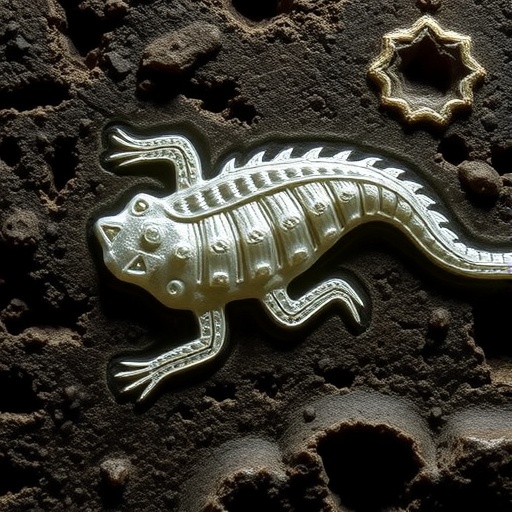In a groundbreaking discovery that reshapes our understanding of early marine ecosystems, researchers have unveiled ‘ghost’ fossils of primitive coccolithophores—microscopic marine algae responsible for producing calcium carbonate plates—that date back to the Triassic period. This finding offers compelling evidence that marine calcifying organisms diversified much earlier than previously thought, challenging long-standing models of oceanic life evolution in Earth’s history.
Coccolithophores are pivotal contributors to the global carbon cycle, forming intricate calcium carbonate shells known as coccoliths. Their fossil record, primarily found in sedimentary chalk deposits, has traditionally indicated a marine diversification burst during the Jurassic era. However, new microscopic analyses reveal subtle, nearly invisible imprints—termed ‘ghost’ fossils—in Triassic-aged rock formations, providing a glimpse into an earlier chapter of coccolithophore evolution.
The international team spearheading this research utilized advanced electron microscopy techniques, which allowed them to detect faint morphological traces that are typically undetectable through conventional paleontological methods. These ‘ghost’ fossils manifest as delicate, calcified halos embedded within sediment matrices, preserving the outline and microstructure of coccolith plates despite the absence of fully formed physical fossils.
This methodological breakthrough is significant because the Triassic period, roughly spanning 252 to 201 million years ago, was a pivotal interval characterized by major biological turnover, recovering biodiversity after the Permian-Triassic mass extinction. The identification of early coccolithophore forms in this era implies a much faster recovery and diversification of marine calcifying organisms than previously acknowledged.
Analyzing the microfossils, the researchers noted distinctive coccolith shapes and arrangements that align with modern coccolithophore lineages. These traits indicate that key physiological mechanisms underlying biomineralization—how these organisms generate their calcified shells—were already established in the Triassic. Such a timeline recalibrates our understanding of evolutionary innovation in planktonic calcifiers.
Beyond paleontological significance, this discovery bears implications for Earth’s past climate regulation. Coccolithophores influence carbon sequestration through their calcification processes and subsequent deposition as marine sediments. The early Triassic emergence of these organisms suggests that complex interactions between biological activity and the carbon cycle existed deeper in Earth’s history, potentially affecting atmospheric CO2 levels and climate dynamics at that time.
The subtlety of the ‘ghost’ fossils necessitated an interdisciplinary approach combining geology, biology, and materials science. Researchers integrated stratigraphic data with geochemical analyses, confirming that the calcified structures corresponded to biological origins and not diagenetic mineral artifacts. This robust analytical framework strengthens the case for recognizing these features as authentic remnants of ancient living cells.
This research also underscores the importance of refining fossil detection technologies, illuminating previously inaccessible windows into the deep past. Conventional fossil hunting often overlooks micro- and nanoscale evidence, which can profoundly alter narratives about the timing and nature of evolutionary radiations among marine microorganisms.
By elucidating the early diversification of marine calcifiers, this study contributes to a broader reconstruction of Paleozoic and Mesozoic marine ecosystems. It signals that calcifying phytoplankton, essential primary producers and ecosystem engineers, were active participants during geological intervals previously thought to be dominated by non-calcified or less structurally complex plankton.
Moreover, the presence of Triassic coccolithophores invites reassessment of biogeochemical feedback loops during the early Mesozoic. With calcite secretion, these microorganisms influence ocean alkalinity and carbonate sedimentation rates. Their early proliferation might have introduced novel patterns of nutrient cycling and carbon shaping that set the stage for later marine biodiversity blooms.
The findings also open exciting avenues for future research. Scientists will now look to explore the genetic and cellular frameworks that enabled such early biomineralization, probing the evolutionary pressures and environmental triggers that guided coccolithophore adaptation and success in post-extinction oceans.
In a broader scientific context, this discovery exemplifies how microscopic evidence can rewrite macro-scale narratives about Earth’s evolutionary past. It challenges assumptions about delayed biological innovation, suggesting that life’s complexity often arises not in sudden bursts but through gradual, persistent developments detectable through subtle fossilized signatures.
The study’s impact extends beyond academic circles, offering tangible insights into how life on Earth responds to extreme environmental upheavals—information crucial for predicting the resilience and adaptability of modern ecosystems facing rapid anthropogenic changes today.
Ultimately, the revelation of these ‘ghost’ coccolithophore fossils affirms that marine calcifying organisms have been shaping Earth’s biosphere and climate for much longer than formerly appreciated, highlighting the enduring interconnectedness of life and planetary processes across hundreds of millions of years.
This landmark study propels scientists to refine models of evolutionary history, marine ecology, and climate interactions, urging a reevaluation of the timelines upon which we base our understanding of life’s persistent drive toward complexity and environmental integration.
As we delve deeper into the sedimentary archives with ever-more sophisticated tools, the silent story told by these faint calcite ghosts reminds us of the vast, largely unseen biological histories encoded in the geological record, waiting to illuminate the chapters of Earth’s ancient oceans.
Subject of Research:
Article Title:
Article References:
Slater, S.M., Demangel, I. & Richoz, S. ‘Ghost’ fossils of early coccolithophores point to a Triassic diversification of marine calcifying organisms. Nat Commun 16, 9283 (2025). https://doi.org/10.1038/s41467-025-65116-0
Image Credits: AI Generated
DOI: 10.1038/s41467-025-65116-0
Keywords: coccolithophores, Triassic period, marine calcification, fossil record, biomineralization, micropaleontology, carbon cycle, paleoceanography




